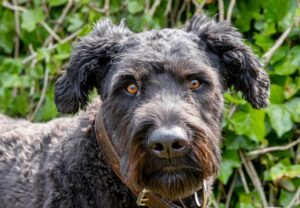The Bouvier des Flandres is a large, impressive and hardy dog, traditionally used as a cattle herder.
It has a strong frame, dense waterproof double coat and a large head accented with a characteristic beard, shaggy eyebrows and moustache. Their working heritage means that this breed is both energetic and intelligent, and as such, requires plenty of space, exercise and time from their owners. They also make excellent guard dogs and do well in dog sports, such as tracking, herding and carting. With the right owner, this breed will be a devoted and loving companion and guardian to its family. The Bouvier does have a tendency to be dominant, so early training is very beneficial, especially if it is to live alongside other animals. Their superb coat does require daily grooming, to ensure that the loose hairs of the outer coat do not become matted with the dense undercoat.
History

This breed dates back to the Middle Ages when it originated in the Flanders region, which today encompasses regions in France, Belgium and the Netherlands. The name Bouvier means cattle herder and this was the breeds primary purpose. They were nearly wiped out after the World Wars but fortunately, a few were kept alive by the Belgium army. More recently, their tough and strong nature has seen them used by the police and armed services.






